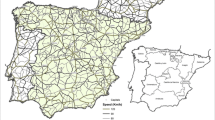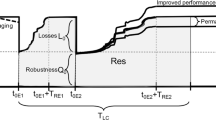Abstract
Estimating the resilience of a road network (one of the essential critical infrastructures in times of crisis) to natural hazards is crucial in achieving the goals of disaster risk reduction (DRR). This study proposes a new predictive method to implement, in an operational way, the concept of resilience by exploring the robustness of the road network in Baalbek-Hermel Governorate (Lebanon) in order to predict its future behavior in response to natural hazards occurrence. The proposed methodology consists of a predictive-spatial-analytic approach based on geospatial numerical models combined with an R-NetSwan function for modeling and simulating critical infrastructures. The results show that Baalbek-Hermel’s road network is moderately resilient since it reaches a total loss of connectivity when nearly 60% of its critical nodes are blocked or damaged. Earthquakes proved to be the most disruptive hazards of this network, threatening the connectivity, starting its first damaged nodes, and causing the highest percentages of connectivity loss (70%). The novelty of this method lies in utilizing network analysis to reveal roads resilience to different natural hazards and serve several operational targets: revealing the defects of the road network for improvement or the construction of new detours, as well as allowing the first aid services to better visualize these weaknesses and to better prepare themselves. This study facilitates the implementation of a proactive approach to DRR and the protection of CI networks for better crisis response and much more effective evacuation plans.

Source: CNRS (2017)






Similar content being viewed by others
References
Abdallah C, Faour G (2017) Landslide hazard mapping of Ibrahim River Basin, Lebanon. Nat Hazards 85(1):237–266. https://doi.org/10.1007/s11069-016-2560-1
Abdallah C, Hdeib R (2015) Flood risk assessment and mapping for Lebanon. Lebanon
Abdallah C, Najem S, Der Sarkissian R, AbedelNabi M (2016a) Hazard and risk assessment for the ministry of energy & water in Lebanon. Beirut-Lebanon
Abdallah C, Najem S, Der Sarkissian R, Nabi MA (2016b) Hazard and Risk Assessment for the Ministry of Public works & transport for Developing a National Critical Infrastructure Protecting Program for Lebanon. Beirut-Lebanon
Albert R, Jeong H, Barabasi A-L (2000) Error and attack tolerance of complex networks. Nature 406(6794):378–382. https://doi.org/10.1038/35019019
Aydin NY, Duzgun HS, Heinimann HR, Wenzel F, Gnyawali KR (2018a) Framework for improving the resilience and recovery of transportation networks under geohazard risks. Int J of Disaster Risk Reduct 31:832–843. https://doi.org/10.1016/j.ijdrr.2018.07.022
Aydin NY, Duzgun HS, Wenzel F, Heinimann HR (2018b) Integration of stress testing with graph theory to assess the resilience of urban road networks under seismic hazards. Nat Hazards 91(1):37–68. https://doi.org/10.1007/s11069-017-3112-z
Bach C, Gupta AK, Nair SS, Birkmann J (2013) Critical infrastructures and disaster risk reduction. National Institute of Disaster Management and Deutsche Gesellschaft für internationale Zusammenarbeit GmbH (GIZ), New Delhi
Becker T, Nagel C, Kolbe TH (2011) Integrated 3D modeling of multi-utility networks and their interdependencies for critical infrastructure analysis, pp 1–20. https://doi.org/10.1007/978-3-642-12670-3_1
Berdica K (2002) An introduction to road vulnerability: what has been done, is done and should be done. Transp Policy 9(2):117–127. https://doi.org/10.1016/S0967-070X(02)00011-2
Blaikie P, Cannon T, Davis I, Wisner B (1996) At risk: natural hazards, people’s vulnerability, and disasters. Human ecology, vol 24. https://doi.org/10.4324/9780203428764
Bruneau M, Chang SE, Eguchi RT, Lee GC, O’Rourke TD, Reinhorn AM et al (2003) A framework to quantitatively assess and enhance the seismic resilience of communities. Earthq Spectra 10(1193/1):1623497
Der Sarkissian R, Zaninetti J-M, Abdallah C (2019) The use of geospatial information as support for disaster risk reduction; contextualization to Baalbek-Hermel Governorate/Lebanon. Appl Geogr 111:102075. https://doi.org/10.1016/j.apgeog.2019.102075
Dudenhoeffer DDD, Permann MMR, Wolsey S, Timpany R, Miller C, McDermott A et al (2007) Interdependency modeling and emergency response. In: Proceedings of the 2007 summer computer simulation conference, vol 2, pp 1230–1237. https://doi.org/10.1145/1357910.1358101
Espada RJ, Apan A, McDougall K (2015) Vulnerability assessment and interdependency analysis of critical infrastructures for climate adaptation and flood mitigation. Int J Disaster Resil Built Environ 6(3):313–346. https://doi.org/10.1108/IJDRBE-02-2014-0019
Eusgeld I, Nan C, Dietz S (2011) “System-of-systems” approach for interdependent critical infrastructures. Reliab Eng Syst Saf 96(6):679–686. https://doi.org/10.1016/j.ress.2010.12.010
Fekete A (2011) Common criteria for the assessment of critical infrastructures. Int J Disaster Risk Sci 2(1):15–24. https://doi.org/10.1007/s13753-011-0002-y
Fulmer J (2009) What in the world is infrastructure? PEI infrastructure investor (July/August), pp 30–32
Ganguly AR, Bhatia U, Flynn SE (2018) Critical infrastructures resilience. Criti Infrastruct Resil. https://doi.org/10.4324/9781315153049
Ghanbari R, Jalili M, Yu X (2018) Correlation of cascade failures and centrality measures in complex networks. Future Gener Comput Syst 83:390–400. https://doi.org/10.1016/j.future.2017.09.007
Girres J-F, Touya G (2010) Quality assessment of the French OpenStreetMap dataset J-F Girres and G Touya quality assessment of the French OpenStreetMap dataset. Trans GIS 14(4):435–459
Gordon K, Dion M (2008) Protection of “critical infrastructure” and the role of investment policies relating to national security
Huijer C, Harajli M, Sadek S (2011) Upgrading the seismic hazard of Lebanon in light of the recent discovery of the offshore thrust. Leban Sci J 12(2):67–82
Kappos AJ, Stylianidis KC, Pitilakis K (1998) Development of seismic risk scenarios based on a hybrid method of vulnerability assessment. Nat Hazards 17(2):177–192. https://doi.org/10.1023/A:1008083021022
Kulawiak M, Stepnowski A (2010) Algorithms for spatial analysis and interpolation of discrete sets of Critical Infrastructure hazard data. In: 2010 2nd international conference on information technology (ICIT), (June), pp 157–160
Kull A (2014) Using the critical path method in analyzing the interdependencies of critical services—feasibility study. In: Lecture notes in computer science (including subseries lecture notes in artificial intelligence and lecture notes in bioinformatics). LNCS, vol 8529, pp 620–629. https://doi.org/10.1007/978-3-319-07725-3_61
Kulldorff M, Heffernan R, Hartman J, Assunção R, Mostashari F (2005) A space-time permutation scan statistic for disease outbreak detection. PLoS Med 2:0216–0224. https://doi.org/10.1371/journal.pmed.0020059
Lhomme S (2015) Analyse spatiale de la structure des réseaux techniques dans un contexte de risques. CyberGeo. https://doi.org/10.4000/cybergeo.26763
Lhomme S, Serre D, Diab Y, Laganier R (2011) A methodology to produce interdependent networks disturbance scenarios. Vulnerability Uncertain Risk. https://doi.org/10.1061/41170(400)88
Lhomme S, Serre D, Diab Y, Laganier R (2013) Analyzing resilience of urban networks: a preliminary step towards more flood resilient cities. Nat Hazards Earth Syst Sci 13(2):221–230. https://doi.org/10.5194/nhess-13-221-2013
Malik HAM, Abid F, Wahiddin MR, Bhatti Z (2017) Robustness of dengue complex network under targeted versus random attack. Complexity 2017:1–12. https://doi.org/10.1155/2017/2515928
McBain W, Wilkes D, Retter M (2010) Flood resilience and resistance for critical infrastructure. CIRIA Publication, London
Moteff J, Parfomak P (2004) Critical infrastructure and key assets: definition and identification. Congressional research service. http://oai.dtic.mil/oai/oai?verb=getRecord&metadataPrefix=html&identifier=ADA454016. Accessed 14 Mar 2019
National Research Council (1999) 3 indirect losses of natural disasters. In: The impacts of natural disasters: a framework for loss estimation. National Academies Press, Washington. https://doi.org/10.17226/6425
National Research Council (U.S.) (2011) Increasing national resilience to hazards and disasters. National Academies Press, Washington. https://doi.org/10.17226/13178
Ongkowijoyo C, Doloi H (2017) Determining critical infrastructure risks using social network analysis. Int J Disaster Resi Built Environ 8(1):5–26. https://doi.org/10.1108/IJDRBE-05-2016-0016
Ouyang M (2014) Review on modeling and simulation of interdependent critical infrastructure systems. Reliab Eng Syst Saf 121:43–60. https://doi.org/10.1016/j.ress.2013.06.040
Ouyang M, Dueñas-Osorio L (2012) Time-dependent resilience assessment and improvement of urban infrastructure systems. Chaos. https://doi.org/10.1063/1.4737204
Ouyang M, Dueñas-Osorio L, Min X (2012) A three-stage resilience analysis framework for urban infrastructure systems. Struct Saf 36–37:23–31. https://doi.org/10.1016/j.strusafe.2011.12.004
Pederson P, Dudenhoeffer D, Hartley S, Permann M (2006) Critical infrastructure interdependency modeling : a survey of critical infrastructure interdependency modeling: A. Idaho National Laboratory. https://doi.org/10.2172/911792
Pescaroli G, Alexander D (2016) Critical infrastructure, panarchies and the vulnerability paths of cascading disasters. Nat Hazards 82(1):175–192. https://doi.org/10.1007/s11069-016-2186-3
Petit F, Verner D, Brannegan D, Buehring W, Dickinson D (2015) Analysis of critical infrastructure dependencies and interdependencies. Argonne Nat Lab. https://doi.org/10.1108/08876040410536503
Pinnaka S, Yarlagadda R, Cetinkaya EK (2015) Modelling robustness of critical infrastructure networks. In: 2015 11th international conference on the design of reliable communication networks, DRCN 2015, pp 95–98. https://doi.org/10.1109/DRCN.2015.7148995
Rao PSC, Krueger E, Klinkhamer CJ (2017) Resilient urban infrastructure? Decision analysis today, vol 36. https://gizmo.com/tag/mobius-strip. Accessed 6 Jan 2019
Reghezz M (2006) La vulnérabilité des sociétés et des territoires face aux menaces naturelles. Géorisque no. 1 (August 2015)
Rinalidi S, Peerenboom J, Kelly T (2001) Identifying, understanding and analyzing critical infrastructure interdependencies. IEEE control system magazine, pp 11–25
Schintler LA, Kulkarni R, Gorman S, Stough R (2007) Using raster-based GIS and graph theory to analyze complex networks. Netw Spat Econ 7(4):301–313. https://doi.org/10.1007/s11067-007-9029-4
Tolone WJ, Johnson EW, Lee S-W, Xiang W-N, Marsh L, Yeager C, Blackwell J (2009) Enabling system of systems analysis of critical infrastructure behaviors, pp 24–35. https://doi.org/10.1007/978-3-642-03552-4_3
Wallace WA, Mendonça D, Lee II EE, Mitchell JE, Chow JH (2003) Managing disruptions to critical interdependent infrastructures in the context of the 2001 world trade center attack. Impacts of and human response to the September 11, 2001 disasters: what research tells us, pp 166–198. https://doi.org/10.1111/j.1539-6924.2010.01401.x
Wolthusen SD (2005) GIS-based command and control infrastructure for critical infrastructure protection. In: Proceedings of first IEEE international workshop on critical infrastructure protection, IWCIP 2005, vol 2005, pp 40–47. https://doi.org/10.1109/IWCIP.2005.12
Zhang P, Peeta S (2011) A generalized modeling framework to analyze interdependencies among infrastructure systems. Transp Res Part B Methodol 45(3):553–579. https://doi.org/10.1016/j.trb.2010.10.001
Zielstra D, Zipf A (2010). A comparative study of proprietary geodata and volunteered geographic information for Germany. In: 13th AGILE international conference on geographic information science, vol 1, pp 1–15. https://doi.org/10.1119/1.1736005
Zimmerman R (2001) Social implications of infrastructure network interactions. J Urban Technol 8:97–119
Acknowledgements
This research is part of a PhD thesis funded by the National Council of Scientific Research-Lebanon (CNRS-L). Authors thank CNRS-L for their funding. Thanks is also extended to editor and reviewers for their valuable comments in leveraging the scientific quality of work.
Author information
Authors and Affiliations
Corresponding author
Additional information
Publisher's Note
Springer Nature remains neutral with regard to jurisdictional claims in published maps and institutional affiliations.
Rights and permissions
About this article
Cite this article
Der Sarkissian, R., Abdallah, C., Zaninetti, JM. et al. Modelling intra-dependencies to assess road network resilience to natural hazards. Nat Hazards 103, 121–137 (2020). https://doi.org/10.1007/s11069-020-03962-5
Received:
Accepted:
Published:
Issue Date:
DOI: https://doi.org/10.1007/s11069-020-03962-5




